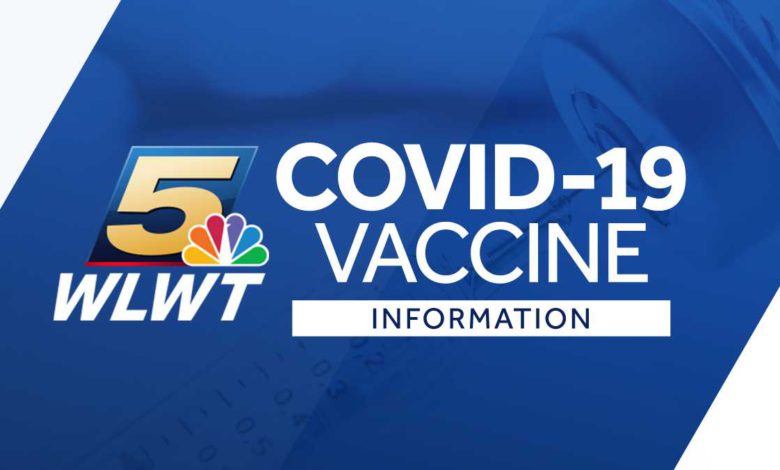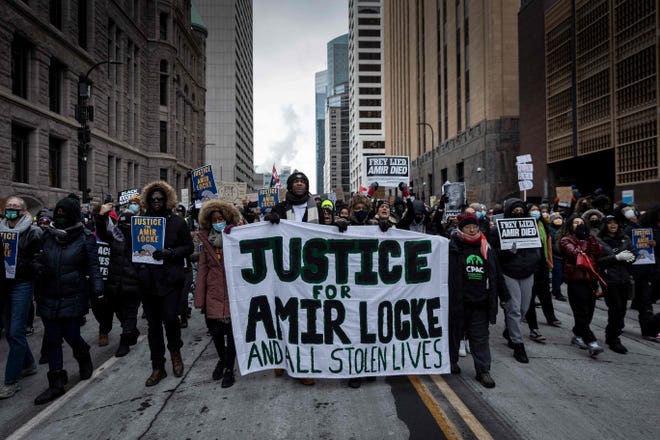
COVID-19 vaccine: Where, when you can get vaccinated in Ohio, Kentucky, Indiana
Good evening, my fellow highlands. One year ago today, our battle against the coronavirus began that day before we made the decision to close the Arnold Classic, knowing that the virus was, in all likelihood, already here. March 4th, 2020 our first full day in this fight. And none of us then fully understood the battle ahead. This has been a tough year. Many of you have lost a parent. Grandparents, sibling, spouse. Some of you have even lost a child. Mhm. Some of you have lost your job. Yeah, Some of you have lost your business yet through this most difficult year we did what Ohio ones always do. We rallied together. We sacrificed. We showed the world our Ohio grit. Our communities have come together. We've done things the Ohio way. We've been careful and we've been curing. And we've worked hard to protect the most vulnerable among us. Because that is what Ohioans do. We protect each other. We take care of our own. In so many of our communities teachers, superintendent, school staff and families have made so many sacrifices this year to keep kids in school all year working so very hard to keep our kids safe. They followed the best safety measures, and those measures have worked. Now Ohio is a true leader in getting the rest of our kids back in school. We vaccinated over 200,000 educators in just four weeks in February, and today nearly 95% of our Children 95% of our Children are back in school. In person learning. We had a plan and we carried it out. You know, we're now in the offense with this virus. We have the most efficient, effective, the most powerful weapon, and that is the vaccine. And we're implementing our Ohio plan to prioritize the deployment of this vaccine to those Ohio is most likely to die if they get the virus. Our order, Ohioans, those living in our communities and also those living in nursing homes and assisted living facilities. Ohioans with Severe developmental disabilities and Ohio is born with very serious life threat threatening medical conditions such as down syndrome, cystic fibrosis or cerebral palsy. Our Ohio plan has made sure that from the very start vaccines are available in every community in the state. Today we have over 1200 separate locations for all Highlands, you can get a vaccine close to their home. Not only that, we've taken the vaccine literally, to the doorsteps, to the doorsteps of people who have other barriers to accessing the vaccine every day. I'm so proud of the volunteers I'm so proud of. The National Guard every day are Ohio National Guard and countless other volunteers are vaccinating people at low income senior housing locations, at churches and a community and health centers and so many other places. To date, we have vaccinated over 1.8 million Ohioans. Now we've got a ways to go. And yes, we need more vaccine. Mhm. But more vaccine is coming. This week, at least 450,000 doses arrived in Ohio more vaccine than any previous week so far. We started our vaccinations in December, starting with long term care facilities, including our nursing homes. At that time, cases in nursing homes were over 2800 per week. Today, after those vaccinations, that number is down to 268 cases per week. 1/10 1 10th of what was but what it was before we started vaccinating and as a result, the number of covid 19 patients in our hospitals has dropped dramatically. We have not just vaccinated are nursing home residents and then going away. Rather, we're implementing an innovative Ohio program that ensures that new residents, new employees and those who initially chose not to take the vaccine all can now get vaccinated. And that will continue in the future in all of Ohio's 930 nursing homes. Yeah, science has shown us that those living with developmental and congenital disorders are also at increased risk of hospitalization and death from covid. The coronavirus, for example, is 10 times deadlier for those living with Down syndrome. And so Ohio has led the way in making vaccine available to these vulnerable individuals. So far, more than 15,000 Ohioans with developmental and congenital disorders have received vaccinations, and more are receiving them every single day. In addition, more than 91% of Ohioans with developmental disabilities who are living in our state's eight developmental centers have also received their vaccines. All of this weaves into our Ohio Story R Ohio plan, and that plan is saving lives. My fellow Highlands victory is in sight. Mhm. We have to keep in mind, though, that there is still a threat out there. Scientists tell us that the virus in Ohio is fast morphing into a more highly contagious virus, and no one no one really knows the full impact that this change might bring. The reality is that Ohioans continue to die each day from the virus. Each death is a tragedy. But there is something seemingly even more tragic and poignant about a death that occurs when the war is almost over and victory is close at hand. Mhm, My dad dicta Wine was a private in the Army, fought in Europe during World War Two. He served in K Company, 103rd Infantry Division of the seventh Army. Dad told me about the final days of the war, and he shared one story that remained with him throughout his life, and this has taken from the official company K History. Go quote from it. The company was strafed by two German M E 109 fighter aircraft as they were pursuing our American P 40 seven's. Yeah, Sergeant Bruno Bochenski was mortally wounded. The men of the third Platoon considered the loss of whiskey is the toughest blow of the campaign. And they brooded for weeks over the cruel quirk of fate which snuffed out the life of one who had come through the really tough days going through those without so much as a scratch. Mhm, mhm. Sergeant Kinski was killed on April 27th, 1945. The war ended just 10 days later. The end of our fight is now in view, but we must continue pressing forward in these final days. We want all Ohioans to complete this vital mission together. Now we must not relent and any struggle when the end is in view, there's a natural human tendency to let up when the job is almost done with kind of pull back a little bit. Sometimes we take our foot off the gas and I understand that I get it. All of us, all of us are so sick of this virus. But, you know, we must resist this urge and we must fight to the very end. I can't tell you exactly the day and the time when we can declare victory, but we will be able to declare victory. I can't predict how this virus will act in the coming days. No one can. But what we do know is this. We're close, we're close. We also know what works. And we know what we need to do to get to the other side of this. To get things back to normal. Not only now do we have three highly effective vaccines. We also have one battle tested tool that is proven to work so well. And that is the mask. Study after study has shown that mass work. In fact, we did our own studying schools and learned that even when kids were not 6 ft apart, even closer than 6 ft and they were in a classroom together for a long time as long as they're wearing a mask, the virus simply simply did not spread Ohioans. You've been doing things right and because of what Ohioans are doing faithfully wearing mask in school, in business and while shopping, we have made significant strides in getting our lives back to normal. The curfew has been lifted. We no longer have stayed home orders, restaurants, bars, gyms are open and we're looking forward. We're looking forward to a spring with graduations and proms and a summer fairs and festivals concerts in baseball. Yes, we may start at 30% capacity for the Reds and the Indians, the minor league teams, but we anticipate that is more and more of us get vaccinated. These percentages will grow until we have full ballparks. Full concert halls, full theaters, full capacity. It's so many other venues. Now let's talk for a moment about how we can measure that success, how we know when we're there. I'm often asked Mike, When is this going to end? When can we lift the health orders? I've consoled a doctor, Vanderhof, our Department of Health, medical director and number of epidemiologists as well as other health experts. And they tell me that now, with the vaccine, we can set realistic goals. And so tonight I'm announcing that when Ohio gets down to 50 cases per 100,000 people for two weeks, all health orders in the state will come off. Now, cases per 100,000 people for a two week period is a standard measure, a measure that we've used since early in the pandemic. We show these numbers every week at our press conferences. Achieving this goal is very doable. We can't do this and I know we will now let me put these numbers in a little context. On December 3rd, 2020 Ohio was at 731 cases per 100,000 population over the previous two weeks, 7 31 on February 3rd, 2021 month ago, Ohio's cases were down to 445 and just yesterday we were down 279 cases. In three months we've gone down 550 cases per 100,000 people. Over the last month alone, we've gone down 265 cases per 100,000. Ohio is on the right path to get us to 50 and this is thanks to the vaccine. And thanks to your hard work and what you are doing every day to help mitigate the virus, our path back is by continuing forward by wearing that mask and by getting that vaccine and while no one will be forced to take the vaccine, the more of us who can get vaccinated and the quicker we can get it done, the more complete will be our victory. The sooner will we have that victory, and the more confidently Can we put this all behind us? Ohio. This is our path back. Mhm. My friends were now in the last few miles of what has been a ruling marathon. Mhm. We're tired, but no marathoner pulls out on purpose at the 25th mile marker. They know that they're almost to the finish line. Mhm. And that is when the marathoner digs even deeper from within to marshal the will to go on to go on to that finish line. In the words of Ohio State legend Olympic hero Jesse Owens, I quote that is the moment when we cannot give in to the pain. And instead of going to limit to the limit, we must go past it. Because that that is where victory is always found. Ohio. We must run through the tape at the end of this race. We need to keep going. We need to finish the job and we need to finish strong. My fellow Ohioans, we can do this. Thank you very much. May God bless all of you. Mhm! Mhm!
COVID-19 vaccine: Where, when you can get vaccinated in Ohio, Kentucky, Indiana
As the COVID-19 vaccine is rolled out across Ohio, Kentucky and Indiana, you can find helpful links and information below to stay informed about the process.WHERE TO GET VACCINATEDOhio's vaccine site lists hundreds of locations where vaccinations are available. There is an interactive map, with locations searchable by location, county or ZIP code. Ohio's COVID-19 Vaccine Sites map. Kentucky's vaccine sites are on this handy interactive map. Kentucky COVID-19 Vaccine Sites mapIndiana also has a handy interactive map that shows you all the locations that are currently offering vaccines. Indiana COVID-19 Vaccine Sites mapWHEN CAN YOU GET VACCINATED?Here are Ohio's phases for rolling out the vaccine:Phase 1A - Health care workers and personnel who are routinely involved in the care of COVID-19 patients; residents and staff in nursing homes; residents and staff in assisted living facilities; patients and staff at state psychiatric hospitals; people with developmental disabilities and those with mental health disorders, including substance use disorders, who live in group homes, residential facilities, or centers, and staff at those locations; Residents and staff at our two state-run homes for Ohio veterans; EMS responders.Phase 1B - Ohioans, age 65 and up; Ohioans with severe congenital, developmental, or early-onset, and inherited conditions including cerebral palsy; spina bifida; severe congenital heart disease requiring hospitalization within the past year; severe type 1 diabetes requiring hospitalization within the past year; inherited metabolic disorders including phenylketonuria; severe neurological disorders including epilepsy, hydrocephaly, and microcephaly; severe genetic disorders including Down syndrome, fragile X syndrome, Prader-Willi syndrome, Turner syndrome, and muscular dystrophy; severe lung disease, including asthma requiring hospitalization within the past year, and cystic fibrosis; sickle cell anemia; and alpha and beta thalassemia; and solid organ transplant patients; Adults/employees in K-12 schools that want to go back, or to remain, educating in person.Phase 1C - Those included in 1C include individuals working in child care services, funeral services and law enforcement and corrections officers. In addition, anyone with type 1 diabetes, pregnant women, bone marrow transplant recipients and those living with ALS are able to be vaccinated in the state of Ohio. Phase 1D: Phase 1D includes those with Type 2 Diabetes and end-stage renal disease. Individuals in this phase are eligible for the vaccine on March 11.Phase 2: Ohioans age 60 and over. Phase 2B: Ohioans over the ages of 50. Individuals in this phase are eligible for the vaccine on March 11.CURRENTLY: Ohioans 60 and older can receive the vaccine. Additionally, individuals working in child care services, funeral services and law enforcement and corrections officers can receive the vaccine. In addition, anyone with type 1 diabetes, pregnant women, bone marrow transplant recipients and those living with ALS are able to be vaccinated in the state of Ohio. This phase will begin Thursday, March 4. Groups 1A and 1B are also ongoing.Here are Kentucky's phases for rolling out the vaccine:1A - Long term care facilities, assisted living facilities, health care personnel1B - First responders, anyone age 70 or older, K-12 school personnel, child care providers1C - Anyone age 60 or older, anyone age 16 or older with CDC highest risk C19 risk conditions, all essential workers2 - Anyone age 40 or older.3 - Anyone age 16 or older.4 - Children under the age of 16 if the vaccine is approved for this age group (est. 18% of KY population)CURRENTLY: The state is only serving groups 1A, 1B and 1C. Priority still on ages 60 and up.If you are an Indiana resident and answer yes to any of these questions, you are eligible to receive the COVID-19 vaccine:Are you age 50 or older?Do you work or volunteer in healthcare and have (physical or close) contact or face to face interactions with patients? Examples include: Inpatient, outpatient, provider office setting, nursing homes, residential care facilities, assisted living facilities, in-home servicesThis includes all clinical and non-clinical positions: clinicians, dietary, environmental services, administrators who have direct contact with patients, clergy who see patients in the healthcare setting, non-clinicians who assist in procedures, transportation staff, etc.This also includes local health department staff who interact with patients at test sites, health clinics or provide direct patient careDo you have exposure to COVID-19 infectious material? (Examples include cleaning of rooms or material from COVID-19 patients, performing COVID-19 testing, other exposure to infected tissue, performing autopsies or other post-mortem examinations of COVID-19 patients)Are you a first responder (firefighter, police officer and sheriff’s deputy, emergency medical services, reservist and correctional officer) who is regularly called to the scene of an emergency to give medical aid?CURRENTLY: The state is prioritizing ages 50 and up. HOW TO SCHEDULE A VACCINE APPOINTMENTOhio, Kentucky and Indiana link to registration through their vaccine site maps:Ohio, click here. Kentucky, click here. Indiana, click here.Find your site and follow the prompts.**Note: Appointments may be hard to come by as state supply is low. Keep an eye out for waitlists in your area. WHAT DOES IT COST?The two-dose COVID-19 vaccines from Pfizer and Moderna are obtained and distributed by the federal government. The vaccine will be provided at no cost, regardless of whether someone has health insurance.Providers can bill for an office visit when administering the COVID-19 vaccine if the visit meets the criteria for office visit coding under the patient’s plan.IS IT SAFE?The CDC says, "COVID-19 vaccines are safe and effective. Millions of people in the United States have received COVID-19 vaccines, and these vaccines have undergone the most intensive safety monitoring in U.S. history. This monitoring includes using both established and new safety monitoring systems to make sure that COVID-19 vaccines are safe."The COVID-19 vaccines currently being developed in the U.S. don't use the live virus that causes COVID-19.Important to note: It will take a few weeks for your body to build immunity after getting a COVID-19 vaccination.STILL HAVE MORE QUESTIONS?Ohio hotline: 1-800-282-0546 (Ohio only)Kentucky hotline: 800-722-5725Indiana hotline: 877-826-0011 (8 a.m. to 5 p.m. daily for general public)
As the COVID-19 vaccine is rolled out across Ohio, Kentucky and Indiana, you can find helpful links and information below to stay informed about the process.
WHERE TO GET VACCINATED
Ohio's vaccine site lists hundreds of locations where vaccinations are available. There is an interactive map, with locations searchable by location, county or ZIP code. Ohio's COVID-19 Vaccine Sites map.
Kentucky's vaccine sites are on this handy interactive map. Kentucky COVID-19 Vaccine Sites map
Indiana also has a handy interactive map that shows you all the locations that are currently offering vaccines. Indiana COVID-19 Vaccine Sites map
WHEN CAN YOU GET VACCINATED?
Here are Ohio's phases for rolling out the vaccine:
- Phase 1A - Health care workers and personnel who are routinely involved in the care of COVID-19 patients; residents and staff in nursing homes; residents and staff in assisted living facilities; patients and staff at state psychiatric hospitals; people with developmental disabilities and those with mental health disorders, including substance use disorders, who live in group homes, residential facilities, or centers, and staff at those locations; Residents and staff at our two state-run homes for Ohio veterans; EMS responders.
- Phase 1B - Ohioans, age 65 and up; Ohioans with severe congenital, developmental, or early-onset, and inherited conditions including cerebral palsy; spina bifida; severe congenital heart disease requiring hospitalization within the past year; severe type 1 diabetes requiring hospitalization within the past year; inherited metabolic disorders including phenylketonuria; severe neurological disorders including epilepsy, hydrocephaly, and microcephaly; severe genetic disorders including Down syndrome, fragile X syndrome, Prader-Willi syndrome, Turner syndrome, and muscular dystrophy; severe lung disease, including asthma requiring hospitalization within the past year, and cystic fibrosis; sickle cell anemia; and alpha and beta thalassemia; and solid organ transplant patients; Adults/employees in K-12 schools that want to go back, or to remain, educating in person.
- Phase 1C - Those included in 1C include individuals working in child care services, funeral services and law enforcement and corrections officers. In addition, anyone with type 1 diabetes, pregnant women, bone marrow transplant recipients and those living with ALS are able to be vaccinated in the state of Ohio.
- Phase 1D: Phase 1D includes those with Type 2 Diabetes and end-stage renal disease. Individuals in this phase are eligible for the vaccine on March 11.
- Phase 2: Ohioans age 60 and over.
- Phase 2B: Ohioans over the ages of 50. Individuals in this phase are eligible for the vaccine on March 11.
CURRENTLY: Ohioans 60 and older can receive the vaccine. Additionally, individuals working in child care services, funeral services and law enforcement and corrections officers can receive the vaccine. In addition, anyone with type 1 diabetes, pregnant women, bone marrow transplant recipients and those living with ALS are able to be vaccinated in the state of Ohio. This phase will begin Thursday, March 4. Groups 1A and 1B are also ongoing.
Here are Kentucky's phases for rolling out the vaccine:
- 1A - Long term care facilities, assisted living facilities, health care personnel
- 1B - First responders, anyone age 70 or older, K-12 school personnel, child care providers
- 1C - Anyone age 60 or older, anyone age 16 or older with CDC highest risk C19 risk conditions, all essential workers
- 2 - Anyone age 40 or older.
- 3 - Anyone age 16 or older.
- 4 - Children under the age of 16 if the vaccine is approved for this age group (est. 18% of KY population)
CURRENTLY: The state is only serving groups 1A, 1B and 1C. Priority still on ages 60 and up.
If you are an Indiana resident and answer yes to any of these questions, you are eligible to receive the COVID-19 vaccine:
- Are you age 50 or older?
- Do you work or volunteer in healthcare and have (physical or close) contact or face to face interactions with patients? Examples include: Inpatient, outpatient, provider office setting, nursing homes, residential care facilities, assisted living facilities, in-home services
- This includes all clinical and non-clinical positions: clinicians, dietary, environmental services, administrators who have direct contact with patients, clergy who see patients in the healthcare setting, non-clinicians who assist in procedures, transportation staff, etc.
- This also includes local health department staff who interact with patients at test sites, health clinics or provide direct patient care
- Do you have exposure to COVID-19 infectious material? (Examples include cleaning of rooms or material from COVID-19 patients, performing COVID-19 testing, other exposure to infected tissue, performing autopsies or other post-mortem examinations of COVID-19 patients)
- Are you a first responder (firefighter, police officer and sheriff’s deputy, emergency medical services, reservist and correctional officer) who is regularly called to the scene of an emergency to give medical aid?
CURRENTLY: The state is prioritizing ages 50 and up.
HOW TO SCHEDULE A VACCINE APPOINTMENT
Ohio, Kentucky and Indiana link to registration through their vaccine site maps:
Ohio, click here. Kentucky, click here. Indiana, click here.
Find your site and follow the prompts.
**Note: Appointments may be hard to come by as state supply is low. Keep an eye out for waitlists in your area.
WHAT DOES IT COST?
The two-dose COVID-19 vaccines from Pfizer and Moderna are obtained and distributed by the federal government. The vaccine will be provided at no cost, regardless of whether someone has health insurance.
Providers can bill for an office visit when administering the COVID-19 vaccine if the visit meets the criteria for office visit coding under the patient’s plan.
IS IT SAFE?
The CDC says, "COVID-19 vaccines are safe and effective. Millions of people in the United States have received COVID-19 vaccines, and these vaccines have undergone the most intensive safety monitoring in U.S. history. This monitoring includes using both established and new safety monitoring systems to make sure that COVID-19 vaccines are safe."
The COVID-19 vaccines currently being developed in the U.S. don't use the live virus that causes COVID-19.
Important to note: It will take a few weeks for your body to build immunity after getting a COVID-19 vaccination.
STILL HAVE MORE QUESTIONS?
Ohio hotline: 1-800-282-0546 (Ohio only)
Kentucky hotline: 800-722-5725
Indiana hotline: 877-826-0011 (8 a.m. to 5 p.m. daily for general public)
Source link










